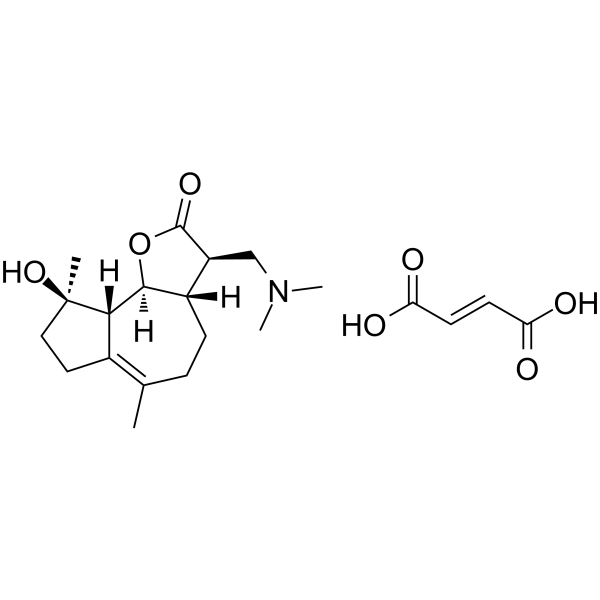ACT001
Modify Date: 2025-08-25 18:08:39

ACT001 structure
|
Common Name | ACT001 | ||
|---|---|---|---|---|
| CAS Number | 1582289-91-5 | Molecular Weight | 409.47 | |
| Density | N/A | Boiling Point | N/A | |
| Molecular Formula | C21H31NO7 | Melting Point | N/A | |
| MSDS | N/A | Flash Point | N/A | |
Use of ACT001ACT001 is an orally active PAI-1 inhibitor by inhibiting the phosphorylation of PI3K and AKT. ACT001 inhibits the phosphorylation of STAT3 and PD-L1 expression by directly binding to STAT3. ACT001, a fumarate salt form of DMAMCL (a prodrug of Micheliolide), can cross the blood-brain barrier. ACT001 has potent anti-glioblastoma (GBM) activity and immunomodulatory effects[1][2]. |
| Name | ACT001 |
|---|
| Description | ACT001 is an orally active PAI-1 inhibitor by inhibiting the phosphorylation of PI3K and AKT. ACT001 inhibits the phosphorylation of STAT3 and PD-L1 expression by directly binding to STAT3. ACT001, a fumarate salt form of DMAMCL (a prodrug of Micheliolide), can cross the blood-brain barrier. ACT001 has potent anti-glioblastoma (GBM) activity and immunomodulatory effects[1][2]. |
|---|---|
| Related Catalog | |
| Target |
p-STAT3 PI3K Akt |
| In Vitro | ACT001 (0-1000 μM; 24-96 hours) decreases cell viability when the concentration was higher than 10 μM in SNB19, U251MG cell lines[1]. ACT001 (10 μM; 48 h) can induce apoptosis in U118MG cells. ACT001 (3.75, 7.5 μM; 48 h) combined with Cisplatin (1-100 μM) increases the apoptosis of U118MG cells over either drug alone[2]. ACT001 (20-80 μM) decreases the expression of PD-L1 and phosphorylation of STAT3 in a dose-dependent manner[1]. ACT001 (10-40 μM) significantly decreases PD-L1 expression in a dose-dependent manner[1]. ACT001 (10 μM) inhibits the migration, invasion and vascular formation ability of U118MG cells[2]. Cell Viability Assay[1] Cell Line: SNB19, U251MG and TJ179 cell lines Concentration: 10, 100, 1000 μM Incubation Time: 24, 48, 72, 96 hours Result: Cell viability decreased when the concentration was higher than 10 μM, and the TJ179 cell line was most sensitive to high concentrations (40-80 μM). Apoptosis Analysis[2] Cell Line: U118MG cells Concentration: 10 μM Incubation Time: 48 hours Result: Inducd apoptosis and that the inhibition effects cannot be enhanced by PAI-1 knockdown. Western Blot Analysis[1] Cell Line: SNB19, U251MG and TJ179 cell lines Concentration: 20, 40, 80 μM Incubation Time: Result: Decreased the p-STAT3 level whereas the STAT3 level did not vary significantly from that of β-Actin. Decreased PD-L1 expression relative to the expression of the loading control β-Actin. RT-PCR[1] Cell Line: SNB19, U251MG and TJ179 cell lines Concentration: 10, 20, 40 μM Incubation Time: Result: Significantly decreased PD-L1 expression in a dose-dependent manner. |
| In Vivo | ACT001 (100 or 400 mg/kg/day; Orally; starting on day 7 for 42 days) significantly causes survived longer than control mice and decreases p-STAT3 and PD-L1 expression with 400 mg/kg[1]. ACT001 (200 mg/kg/day; oral administration) enhances the antitumour effect of Cisplatin (2.5 mg/kg, once every 3 days, IP) in U118 xenograft model[2]. Animal Model: C57BL/6 immuno-competent mice (6 weeks old)[1] Dosage: 100 or 400 mg/kg Administration: Orally; every day starting on day 7 for 42 days Result: Significantly caused survived longer than control mice with 400 mg/kg, and has no significant survival benefit with 100 mg/kg. Decreases p-STAT3 and PD-L1 expression and inhibits the progression of glioma with 400 mg/kg. Decreased M2 macrophage numbers and increases antitumor immune response with 400 mg/kg. |
| References |
| Molecular Formula | C21H31NO7 |
|---|---|
| Molecular Weight | 409.47 |